#Harlequin France
Explore tagged Tumblr posts
Text

Les Modes : revue mensuelle illustrée des arts décoratifs appliqués à la femme, no. 25, vol. 3, 1 janvier 1903, Paris. Jean Béraud. — Arlequine. Bibliothèque nationale de France
#Les Modes#20th century#1900s#1903#periodical#fashion#fashion plate#color#Jean Béraud#masquerade#harlequin#bibliothèque nationale de france#dress#costume#january color plates
214 notes
·
View notes
Text

Pierrot The Seducer:
~<>~<>~<>~
Genie bottle decanter;
A rising crystal spout;
Garnished with stop—
Stop of cut glass—
And lapidary geometrics.
A billowing base
Of crystal, folded pleats.
Louched contents:
Silken, waxen, milky.
Valetaille circling
The Lucullan banquet,
Pouring libations
At behest of the Host.
Gourmandizing revelers
Turn interrupted
To the symposiarch's toast,
Rendered in verse
Of lines decked in motley.
A fool at the table
Has dropped the ladle
And surrended his power
Before behemoth encroachment
Of fast-swelling sadness,
And nacreous teardrops
Break on the floorboards,
Fallen from a head
Defeated and hung.
Gathering his garb
And long-hanging sleeves,
He begs his pardon
And takes his leave
To the parterre,
With light of the moon
Flooding the hedgerows
Like lunar monsoons;
There to breathe...
Lungs drawing fully
The crystalline air
And now assuming
A curious stare
With eyes magnetized
To the light-giving beacon,
He flies in his mind
Through capers unreasoned;
Polyamorous playbooks.
Spellbroken and leering,
He returns to the party,
Brimming w/ glee
At returning thus tardy.
Discordant ripples
He pulls of a quiver,
Espying at nipples,
And young fleshly slivers;
The skipper charts course.
And one chanteuse—
A socialite dame—
Lofty and gorgeous,
He'll rob of her name,
With gallantry feigned
Or impassioned blame,
His design's executions
Are the end of his aim;
Lunar ecstasy.
(FINIS)
#poetry#verses#rhyme#meter#france#pierrot#decadence#new contemporary#seduction#clowns#literature#creative wrting#historical#fin de siècle#commedia dell'arte#harlequin#late 19th century
3 notes
·
View notes
Text
only thing that would've made it cooler is if The Individual backflipped off of it and whipped his mask away to reveal another mask beneath it
okay pretty dang cool olympic cauldron
#except the new mask is a harlequin mask#gosh I should've been in charge of this whole thing#Olympics#x#France
17 notes
·
View notes
Text






JEAN-LÉON GÉRÔME - THE DUEL AFTER THE MASQUERADE, 1857
A grey, misty morning in the Bois de Boulogne, Paris. The ground is covered with snow, a sword, and some feathers lying in it. On the right, we see the winner of a duel, dressed in an American Indian costume, escorted away by his second, a harlequin. All our attention is focused on the left, where the clear white of pierrot’s clothes is matched by the colour of his face and arms. His posture makes it clear he is dying. The man in red, dressed in a Venetian Dogue, is trying to stop the bleeding. The man dressed as Duc de Guise is holding Pierrot in support while the person dressed in a classic Domino is holding his head in despair.
In 19th-century France, duelling was a recognized method of resolving disputes over honor, particularly among the aristocracy and upper classes. By setting the duel after a masquerade, Gérôme taps into this cultural practice, highlighting how quickly social festivities could turn into matters of life and death. Masquerades were known for their anonymity, allowing for behaviors and interactions that might not occur in regular social settings. This setting could lead to misunderstandings, insults, or provocations that might result in duels.
Although duels were technically illegal, they were often tolerated or even celebrated in certain social circles. The painting subtly critiques this acceptance by showing the aftermath in a public setting. The Duc d'Aumale was a significant patron of the arts, and he had a particular interest in Gérôme's work (even purchasing this piece). This relationship shows Aumale's role in supporting Gérôme's career by acquiring his works for his private collection, which later became part of the public domain through his bequest to the Institut de France.
61 notes
·
View notes
Text
Interview with the Vampire characters as Commedia dell'Arte stock archetypes
I talked a bit about why I thought it was such an interesting choice to have Lestat playing Harlequin (Arlecchino) instead of Lelio (the Innamorato) so I thought it would be fun to pair up other characters. The thing about the commedia is that the characters are intentional stock figures - they're meant to be immediately recognisable as like, the vain princess, or the miserly old guy, but their portrayal and the way they evolved through theatrical traditions across Europe can differ quite a lot. None of these characters are especially complimentary to be compared to and their nature does not lend itself to a one-to-one match up!
It's been about six years since I studied anything to do with the commedia (with the exception of a very odd, three month long, masked clowning course i took in France a few years ago), so this is going to be pretty vibes-based as opposed to in-depth analysis, especially since all the IWTV characters are so wildly complex.
Lestat as Arlecchino:
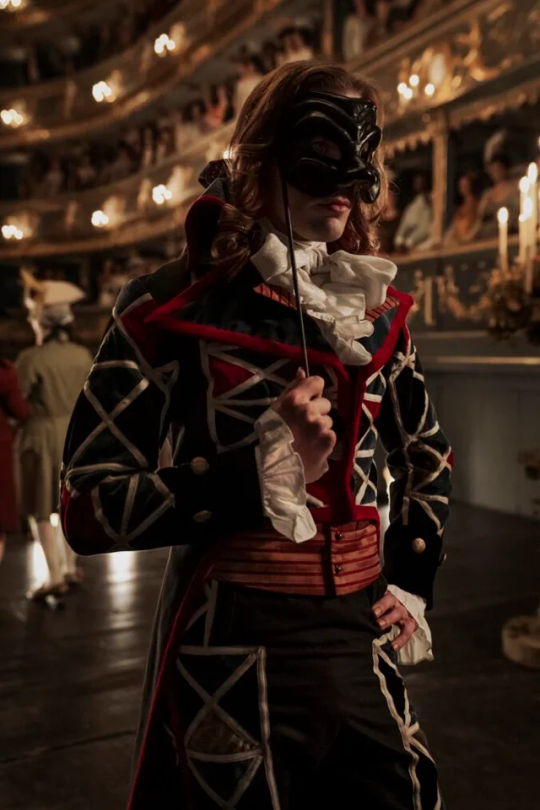
Harlequin, or Arlecchino, isn't really a classic clown within the commedia - he's much more sophisticated and tricky, and his background as a stock character evolved from a demonic character in earlier plays (specifically French ones!)
A very fun backstory for Arlecchino dates back to Medieval France, where the Mesnée d'Hellequin (the French version of the Wild Hunt), roamed the countryside, led by a demonic figure in black and red (classic Harlequin colours).
Arlecchino was a member of the zanni servant characters, but in the French tradition, evolved into much more of a romantic hero. His mask here is a pretty typically zanni mask, with the characteristic pug nose and 'devilish' eyes - but what's interesting is the length of the mask's nose. The zanni were almost always masked, and as the comic relief characters, they traded a lot on stupidity and clowning, but the length of the nose became a sort of shorthand for HOW stupid each one was (lots to unpack there, but I don't know nearly enough to go into it). For Lestat's mask, the nose is pretty short; he's not playing an idiotic simpleton, he's playing the more devilish, charming version of Arlecchino who was beloved in the French tradition.
However, he's also conniving and greedy, and generally just sort of a pain who demands a lot of attention. There's a reason he's the character than most people have some sort of familiarity with.
It honestly makes a lot of sense for Lestat to be Arlecchino after becoming a vampire - Arlecchino is the mischief maker who keeps the action going, known for his agility, demands attention, and beloved by the audience. He would've been a lot more fun to play than the more one-note innamorato!
Louis as Pantalone:
This was tough, because as funny as Louis is, he's a deeply dramatic character vs a comic one. However! The case for Pantalone: Pantalone is a member of the vecchi, and he's the wealthy, money-obsessed miser (the first vampire capitalist? why not!) and the only thing he loves more than money is his daughter. He's immensely protective of his daughter, who is often styled as the innamorata, one of the young lovers, and will go to great lengths to keep her apart from her love. As much as he may call it love, his relationship with the innamorata is a very possessive one - she is not seen on her own terms, even through the eyes of Pantalone, she remains the archetype of foolish, feminine youth.
Pantalone is also a loner, with few friends or confidantes, but he enjoys the power and status that his money affords him, and he doesn't hesitate to wield it, or chase more.
They diverge when it comes to desirability. Pantalone is forever chasing, yet always being rebuffed by the inappropriately younger women than he pursues. Louis on the other hand, has never heard 'no' from a perspective partner (nor should he).
Armand as Brighella:
This bitch is a LIAR (i love him). Brighella is another member of the zanni, and he is a consummate liar. He's also incredibly adaptable - suiting any narrative need, and twisting into any role that needs filling. He may be a servant, lower-class tradesman, or barkeep; whatever the scene calls for. In the older forms of the commedia, he's a pretty nasty guy - he rises from extreme poverty and then becomes cruel and violent to those he's newly superior to. However, he's never portrayed as brutish, or stupid - he's wily, and he's been described as the smarter older brother of Arlecchino. Tragically for Brighella, his popularity with audiences declined as Arlecchino came onto the scene, and he became largely eclipsed by the other zanni character.
It's easy to draw parallels here with Lestat and Arlecchino - Lestat enters the story, shakes up Armand's control of the coven, and comes out on top, popular and adored. Armand's influence quickly wanes in the face of his garish, acrobatic Arlecchino.
Daniel as Beltrame:
I fully forgot about Beltrame and only found him because I was struggling with Daniel. Beltrame is, appropriately, often associated with Brighella, either as a character variation, or as a family member (an off-shoot of the original? like a fledgling? carrying out the purpose of the other character? like a minion? this is a stretch. ignore me).
Beltrame is the clever villager, noted for his wits, his skillful arguments, and his scheming. He gets what he wants, but it's not super important to him how he gets it. Unlike Arlecchino, he can lie, and he can play at having good manners - so long as it serves his purpose.
Unfortunately, there isn't tons of info on Beltrame - the trouble with the zanni characters is many of them became conflated with one another, and it's hard to distinguish between them. Regardless, I think he's probably the best fit, mostly based on his rhetorical skills and association with Brighella.
#iwtv#amc iwtv#interview with the vampire#lestat de lioncourt#louis de pointe du lac#jacob anderson#sam reid#armand#assad zaman#the vampire chronicles#daniel molloy#eric bogosian#commedia dell'arte
49 notes
·
View notes
Text
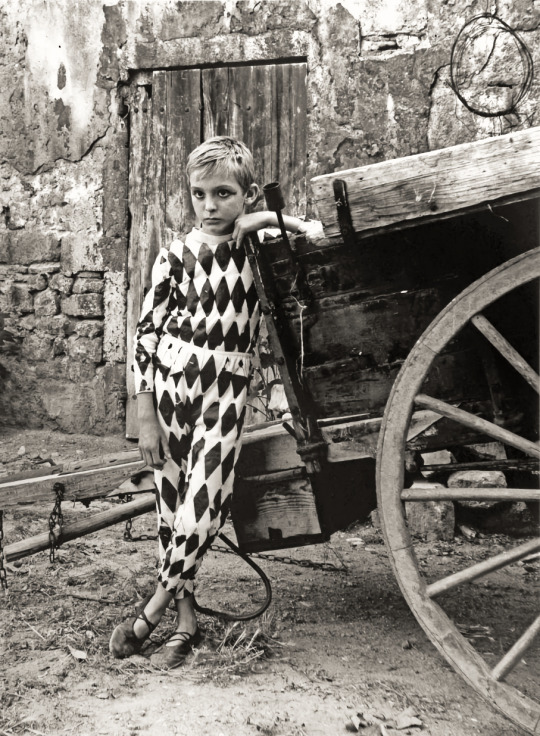
Harlequin with a cart, Arles, France, 1955 - by Lucien Clergue (1934 - 2014), French
229 notes
·
View notes
Text
4KOTA HIGHSCHOOL AU
Liones University
Founder - Bartra Liones President - Meliodas Vice President - Gilthunder Prefect of Disipline - Dreyfus School Doctor - Hendrickson Middle School Principal - Guila Highschool Principal - Howzer Drama Teacher - Gowther PE and Science Teacher - Derieri PE Teacher - Griamore
Known Groups (Past):
The Seven Deadly Sins - Delinquent Gang led by Meliodas (yes, the president of the school) Members: Meliodas - Former Leader of The Ten Commandments; President of Liones University Ban - Owner of Fox's Sin (Bar & Resto) Escanor - Veteran Soldier Harlequin - Alias: King; Fashion and Costume Designer; Owner of Chastiefol (Fashion Clothing Brand) Diane - Former Ballerina; Model for Chastiefol Gowther - Drama Teacher of Liones University; Producer and Owner of Nadja Theater Merlin - Former Vice President of Camelot Academy
The Ten Commandments - Delinquent Gang led by Zeldris Members: Zeldris - Owner of Underworld Corp. Mael - Former Member of The Four Archangels Derieri - PE and Science Teacher of Liones Academy Monspeet - In the US Gloxinia - In France Drole - Also in France Melascula - Professor at Camelot University Galland - Professor at Camelot University Grayroad - <No information found> Fraudrin - <No information found>
The Four Archangels - Student Council Group Members: Ludociel - President Mael - Former Vice President turned member of the Ten Commandments Sariel - Secretary Tarmiel - Comittee Chairman
Known Groups (Present):
The Four Knights of the Apocalypse - just a gaggle of individuals Members: Lancelot - Captain of the Basketball Team; Models for Chastiefol in his free time (either he gets paid or he gets free stuff); Straight A Student (he doesn't even try); Subject of expertise - Math Percival - The most innocent bean known around Campus; Subject of Expertise - Foreign Language (doesn't know why he's good at it) Gawain - Former Camelot University Student; Captain of the Women's Volleyball team; Straight A Student; Self proclaimed chick magnet; Subject of Expertise - Science Tristan - Student Council President; Straight A Student (you're doing great sweetie); Subject of Expertise - Science and History
Percival Platoon - 4kota sub-group led by Percival Members: Anne - President of Fencing Club; Straight A Student; Subject of Expertise - English Donny - Varsity Basketball Player; Subject of Expertise - PE Nasiens - Hendrickson's assistant; Models for Chastiefol in his free time (automatic free stuff); has an obvious crush on Percy; Straight A Student; Subject of Expertise - Science and Geography
Tristan Platoon - 4kota sub-group led by Tristan Members: Isolde - Cheer Captain; has an obvious crush on Tristan; Subject of Expertise - Art and Design Chion - Campus A-hole; Does not care about anybody except for Tristan (Isolde and Jade too but mainly Tristan); Subject of Expertise - Science and History Jade - The tolerable one; has an obvious crush on Isolde; Subject of Expertise - Geography
Lancelot Platoon - 4kota sub-group led by Lancelot Members: Sixtus - Foreign Exchange Student (currently in France staying with Uncle Glox and Drole); Subject of Expertise - History (really good at memorizing specific dates) Tioreh - Member of the Gymnastics Club; Subject of Expertise - Arts and Design
#we don't have gawain platoon yet#I'll add it once we got characters that fit the criteria#i had so much fun writing this#nanatsu no taizai#four knights of the apocalypse#seven deadly sins#nnt#4kota#mokushiroku no yonkishi#seven deadly sins sequel#nanatsu no taizai mokushiroku no yonkishi#everyone is here#lancelot#tristan liones#percival#gawain#sixtus#tioreh#nasiens#anne#donny#chion#jade#yes he's alive#isolde
68 notes
·
View notes
Text

Batman: The Animated Series - Paper Cut-Out Portraits and Profiles
Harleen Quinzel
Once a talented albeit unscrupulous psychiatrist, Doctor Harleen Frances Quinzel came to work at Arham Asylum for her postdoctoral internship. Therein she met The Joker and in her youthful ambition believed that she could successfully treat the so-called clown prince of crime. At first it seemed as though Dr. Quinzel was making excellent progress with The Joker. And yet it turned out that The Joker was slowly and successfully indoctrinating the young woman into his own twisted outlook on the world. Employing a string of lies and false accounts, The Joker was able to make Quinzel see him as the victim. Before she knew it, Quinzel was hopelessly and nearly irrevocably entranced by the villain.
Fashioning herself a harlequin outfit along with a variety of thematic weapons, Quinzel broke The Joker out of Arkham and thus began a colorful career as Harley Quinn, the Joker’s partner in crime. In her delusional state, Harley never saw The Joker as actually hurting anyone; he was merely bringing mirth and mayhem into their otherwise dull lives. Similarly, Harley was unable to appreciate the abusive nature of her relationship with The Joker, how he mistreated her and took her for granted. It was only through her loving relationship with fellow villainess, Poison Ivy, that Harley enjoyed a respite from the toxic thrall of The Joker.
The wonderful Arleen Sorkin provided the voice for Quinzel, with the character first appearing in the seventh episode of the first season of Batman: The Animated Series, ‘Joker’s Favor.’
#batman the animated series#Batman#Harley Quinn#Harleen Quinzel#Arleen Sorkin#cut-out#paper art#DC Comics
96 notes
·
View notes
Text
one of my favorite political tendencies to run into is the like, 1960-1970 obsession with like, the revolutionary potential of the prank or that the schedule is the ultimate killer. "'Repent, Harlequin!' Said the Ticktockman", "Chronopolis". Situationist International, a revolutionary movement whose philosophy might be summed up as "how could capitalism stand up to the might of Some Funny Shit Happening On Your Commute?" and then yknow, accidentally became the theoretical backing of '68 in France. Discordianism "maybe if we do weird shit people will realize that it's ALL fake" (sorry discordianism for attempting to boil it down to a coherent point.) the legacy of culture-jamming and everyone on tumblr really believing in the revolutionary potential of the graffiti tag.
like... i don't think its a particularly useful leftist revolutionary politics-"ugh! ze sheeple, zey do not even look at my living statue performance en zeir way to work. ze proletariat, zey buy the téléviseur and the téléviseur tells them what to buy next, eh?" but also like. despite it all being quite silly i do see the appeal. repent, harlequin!
23 notes
·
View notes
Text
Gifts I think the DAO companions would appreciate, outside of giftable in game items! (Pt1, I think this will be a long post if not sectioned)
Sten-
Incense and expensive tea, possibly imported. He talks about how he hates the smell of Ferelden, and misses home; Tea and incense being the most notable scents that stick out to him.
Cookies, or a good recipe for cookies. Everyone in the Fandom has had the dialog where Sten reveals that he enjoys cookies, and that in his homeland, there is no such thing. I think he would greatly enjoy a recipe to be able to bring such a thing back with him- Even if he may not be able to make them himself at home. My memory is fuzzy on qunari custom, but I don't think he'd be particularly allowed to bake.
A wardog of his own- I don't think he'd be permitted to keep it, upon return to the qun. But he has immense respect for Barkspawn, and I think if he were here in 2024, he'd be a great dog dad. I think he'd probably give it to his closest companion upon his return, but he would keep a detailed sketch of it with him always. He'd probably give it a specific title in his native tongue.
This is sort of a separate headcannon, but I think in a modern AU, he'd really like pumpkin spice lattes.- It's always the ones you would never expect.
Shayle-
Obviously, we know they like crystals. They like being pretty, and *sparkling*. So it's not too farfetched to assume they would appreciate gold ore or other shining metals fitted to some of their stone bits- Sort of like.. Magically grafted on with heat? Morrigan could weld them, or I'm sure Sandal could potentially do it.
I think, while they couldn't really read themselves, I think if you brought them books and such, they would enjoy hearing you read it to them. Especially if you manage to find some old records of their own lineage after the orzammar quest line.
I think they would also enjoy being given I big, stone bowl to keep shiny trinkets in- Like a crow, almost. Crystals, cute pebbles, coins, keys, etc. Pretty things for them to look at.
Leliana-
She would love it if you wrote her a poem, regardless of what it was about. I think she'd just be so happy you thought of her and wrote something lovely- I honestly think she'd love it even more if it wasn't the best quality. After all, that would mean you were inspired by her to write something of which you had no prior experience and still tried your best. She'd think it was cute.
I think she'd like it if you gave her one of your own personal favorite books or fables, with little notes on your commentary and theories. She'd love that, honestly.
A ceramic nug. No explanation needed, she loves Nugs. I've got animals I love, too. And if someone gave me a ceramic or plush critter of my choice, I'd be over the moon.
A little on the weird side, I think she'd like a type of porcelain harlequin doll. I can't think of the specific type, but they don't make them the same way anymore.. they're usually from overseas in Germany or Russia or France, you know? The ones that are really glossy and have beautiful line work in the paint? I feel like you found one in the denerim marketplace, imported from Orlais, and it would remind her of another experience she had there or even just of her time as a bard. After all, they weren't *all* unpleasant memories.
Alistair-
A golem doll. Like a little poppet. I don't think it's rare dialogue, but the other day is the first time I noticed it since I first played the game rented from a family video over a decade ago, so.. Yeah. Point is, Alistair mentions in front of "Wonders of Thedas", that Arl Eamon (I think) once bought him a little golem doll as a child, and how he adored it and wondered if there would be one like it at the wonders of thedas.
A griffon figurine. He's a Grey Warden, I think he'd like it. The wardens have always been his real home, and it's truly where he belongs. I think a memento of that is something he'd hold dear.
A book of poems about honoring fallen soldiers. I feel like it may bring him to tears, and perhaps make him confront some extra grief after ostagar, but perhaps it could also bring a sort of comfort. Maybe he isn't the most religious, maybe he has a bit of trauma from the chantry.. But I think he still prays, if only for the ones he's lost.
Again, I think he'd like a war dog. I'll never let him take Barkspawn, but he'd love a pupper of his own. If you gave it to him as a puppy to raise and train all his own, he'd probably be overjoyed.- Off topic, but I headcannon that all companions to the wardens have an extended lifespan, and live and die with their humanoid counterparts if they don't die in battle, kind of like the animal companions do with the avatars in ATLA. Far fetched, and backed by absolutely no real lore as far as I know, but I like to think it's true.
#dragon age#dragon age origins#dao#dragon age alistair#alistair dragon age#alistair theirin#sten#leliana#shale#shayle
17 notes
·
View notes
Text
Collective kintypes / identities / sources
// pt: collective kintypes / identities / sources //

Host
The Diamonds' Pearls (Blue, Yellow and White, does include CG Pearl) (Yellow Pearl is similar to the deadwooddross design)
Spinel (fictive)
White Diamond, Pink Diamond / Rose Quartz
Sapphire, Lapis Lazuli
Opal (unrelated to headmates of Opal's components, more connected to the "Pearl" component than "Amethyst")
Draculaura (Monster High, all iterations)
Rouge the Bat (Sonic the Hedgehog)
Chococat (Sanrio)
Harley Quinn (Batman: The Animated Series)
Alice Angel (cartoon, Bendy franchise)
Black cat, lion, bat, vaporeon, vampire, doll, werewolf and plush
General clownkin (most prominently circus clowns, jesters, pierrots and harlequins)
The Puppet (FNaF 2)
Sarabi (1994 TLK)
Pearl / Dewdrop
Pearl (deadwooddross design, uses source design as a veil) (Fictive)
Lapis Lazuli (fictive source, albeit source disconnected)
Pearl (the mineral)
Blue Diamond
Yellowfang (Warriors)
Foxy (Five Nights at Freddy's 1, the animatronic, not the child's soul)
Clawdeen Wolf (Monster High)
Susie Campbell / Twisted Alice (Bendy franchise)
Secretary bird, snow leopard
Circle Circle, Dot Dot - Frances Focalor
Maria Robotnik (Sonic the Hedgehog, Movie Version) <- Dewdrop will NOT talk about being Maria unless asked at least for now
Ula
Draculaura (Monster High, g1 and g3) (fictive)
Vampire/Succubus hybrid, werewolf (directly connected to her source as Draculaura)
Garnet (Doesn't feel connected to Ruby or Sapphire)
Bat
Nadja of Antipaxos (What We Do in the Shadows) (fictive)
Scar (TLK 1994)
Knuckles the Echidna (Sonic the Hedgehog, specifically the movie version)
Freddy Fazbear (FNaF 1, questioning)
Frankie
Frankie Stein (Monster High, all iterations)
Ruby
Jasper
Jasper
Tiger
Solaris
Yellow Pearl
Lion (animal, not SU character)
Anyone else not listed doesn't have any kintypes minus their sources.
Those who have boundaries on kintypes/identities include;
Ula does not like interacting with out-of-system doubles of Draculaura, Dewdrop is not comfortable interacting with doubles of Crystal Gem Pearl UNLESS we are mutuals. Mutuals are fine.

[ Dividers by enchanthings-a ]
14 notes
·
View notes
Text

La Mode nationale, no. 272, 11 juillet 1891, Paris. No. 1. — Costumes de bains de mer. Bibliothèque nationale de France
(1) Costume de bain, en anacoste bleu-marine. Corsage froncé, décolleté en carré sous un galon blanc fantaisie. Jupe courte, garnie de deux galons et d'une ceinture semblable. Pantalons au-dessous du genou. Grand chapeau de paille. Grand manteau de bain en tissu éponge.
(1) Swimming suit, in navy blue anacoste. Gathered bodice, square neckline under fancy white braid. Short skirt, trimmed with two braids and a similar belt. Trousers below the knee. Large straw hat. Large terry cloth bath coat.
—
(2) Costume de bain forme marine, en lainage crème. Corsage ouvert sur une chemisette crème et bleue, encadré dans un revers de lainage bleu, se terminant au bas du corsage, boutonné. Pantalons courts, garnis par une bande bleue. Manches semblables à la chemisette. Souliers de bain, attachés en cothurnes. Chapeau de paille blanche et bleue, posé sur un bonnet de toile cirée.
(2) Navy swimsuit, in cream wool. Open bodice over a cream and blue shirt, framed in a blue woolen cuff, ending at the bottom of the bodice, buttoned. Short pants, trimmed with a blue band. Sleeves similar to the shirt. Bathing shoes, tied into buskins. White and blue straw hat, placed on an oilcloth cap.
—
(3) Costume marin pour jeune fille. Blouse en lainage bleu foncé, à larges revers crème, brodés d'ancres bleues, entourant un plastron héraldiquement brodé. Jupe plissée tout autour, brodée d'ancres dans le bas, retenue à la taille sous une ceinture crème. Chapeau de paille, très enlevé, doublé par du tulle à pois plissé, avec ancre brodée. Nœud comète en dessus.
(3) Sailor suit for young girl. Dark blue woolen blouse, with wide cream lapels, embroidered with blue anchor, surrounding a heraldically embroidered bib. Skirt pleated all around, embroidered with anchors at the bottom, held at the waist under a cream belt. Straw hat, very stylish, lined with pleated polka dot tulle, with embroidered anchor. Comet knot above.
—
(4) Costume italien pour enfant, fille ou garçon, de 4 à 5 ans. Blouse drapée en lainage rayé blanc et rouge, retenue à la taille par une écharpe nouée sur le devant. Grand col blanc retombant dans le dos, et en pointe devant. Chapeau de paille blanche, pointée de rouge, avec fond arlequin en lainage blanc et rouge.
(4) Italian suit for children, girls or boys, 4 to 5 years old. Draped blouse in white and red striped wool, held at the waist by a scarf tied at the front. Large white collar falling in the back, and pointed in front. White straw hat, tipped with red, with harlequin background in white and red wool.
—
(5) Costume de lainage ivoire uni. Corsage à petites basques, sans petits côtés, entouré par une petite frange boule. Manches bouffantes du haut, serrées dans le bas. Jupe drapée devant et plissée à larges plis derrière. Chapeau de paille blanche, entouré par un froufrou de mousseline de soie ivoire, avec nœud de ruban rouge en crest derrière.
(5) Plain ivory wool suit. Bodice with small basques, without small sides, surrounded by a small ball fringe. Puff sleeves at the top, tight at the bottom. Skirt draped at the front and pleated with wide pleats at the back. White straw hat, surrounded by a frill of ivory silk chiffon, with a red ribbon bow in the crest behind.
Métrage: 9 mètres lainage, grande largeur.
—
(6) Toilette de lainage rouge. Corsage-jaquette fermé et boutonné, à grandes basques, le tout garni de petit velours noir et de boutons blancs. Col rabattu, poches de velours sur les côtés. Jupe plate devant, plissée derrière, brodée en soie noire dans le bas devant, au-dessus de l'ourlet. Chapeau de paille, à bords enlevés, orné sur le côté par un fouillis de gaze de soie rouge.
(6) Red woolen ensemble. Closed and buttoned bodice-jacket, with large basques, all trimmed with small black velvet and white buttons. Turn-down collar, velvet pockets on the sides. Flat skirt at the front, pleated at the back, embroidered in black silk at the bottom of the front, above the hem. Straw hat, with removed brims, decorated on the side with a mess of red silk gauze.
Métrage: 8 mètres lainage rouge, grande largeur.
#La Mode nationale#19th century#1890s#1891#on this day#July 11#periodical#fashion#fashion plate#cover#panorama#description#bibliothèque nationale de france#dress#suit#beach#swim
30 notes
·
View notes
Text
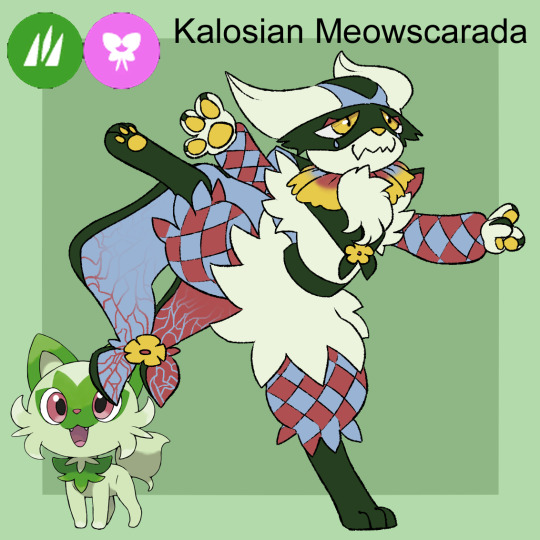
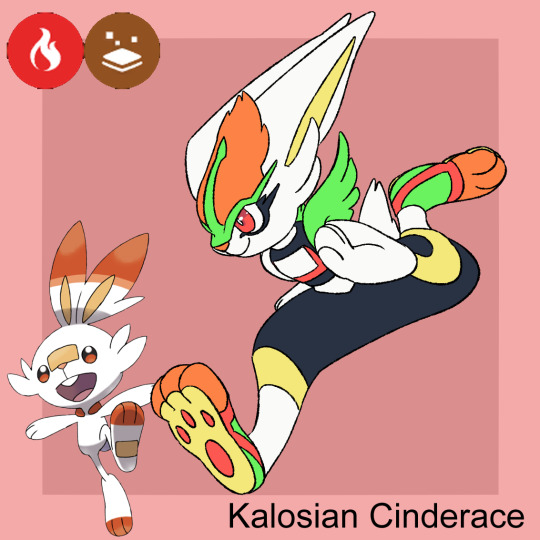

Tried to get back into drawing by creating Pokemon Legends ZA starter evos.
Meowscarada is based on a Harlequin, this was a tough one seeing as I bounced between picking a Pierrot or a Harlequin but ultimately picked Harlequin because it felt easier to choose the secondary type. I went with fairy because of the whole "kids love clowns but adults are terrified" thing, particularly when you realise what fairies are really like. The design looks too busy so I'm not all that happy with it, but I also wanted to try to capture the outfit without looking too 'meh'
Cinderace is based off of a marathon runner with neon running shoes and a paper square-like marking on the chest, seeing as there are one or two (ahem) famous marathons in France. Struggled to secondary type this one, almost went for normal, water (triathalon-based), or even flying (speed) but they just didn't feel right. I eventually went with ground because of all the running, but also because of the funny Napoleon being scared of bunnies story because I feel like he was the kinda guy to double down after a stunt like that
Empoleon is based even more off of Napoleon with his hat, a cape, and jacket patterns (thanks it has pockets). I wanted to add red in to the design seeing as Napoleon had red accents in most of his famous paintings, and changed the crown-like headpiece to match the sideburns . The high collar also got replaced by shoulder pads, and I tried to make the feet resemble Napoleon's boots - although with diddy legs like that it was kinda difficult... Also chose water/dark because damn Napoleon. You sure did some things huh
29 notes
·
View notes
Text
I found back a little excerpt about how Mother Goose arrived into the English literature despite originally being from France. It comes from "Le panorama illustré de la fantasy et du merveilleux" (a really good book). Loosely translated by yours truly
"Perrault's fairy tales influenced the Anglo-Saxon imagination in ways the French readers probably do not conceive: from the 18th century onward, the name of Mother Goose (translation of Mère l'Oye) became synonymous with fairy tales, then with poetry for children, and finally it became a major inspiration for pantomimes and puppet shows.
It was either the famous publisher John Newbery, or his successor Thomas Crana, who, around 1780, began a series of cheap publications derived from the French fairytales (which had been translated in English since 1729). The most ancient edition we have of the anthology "Mother Goose's Melody, or, Sonnets for the cradle" comes from 1784. Its popularity gave birth to stage-shows as early as 1806/1807 (Harlequin and Mother Goose: or, The Golden Egg). Sliding from the world of fairy tales to the one of childhood verses, the character of "Mother Goose" was envisioned as the author of the "nursery rhymes", those small poems learned by all children in England - hence why Mother Goose was a primary influence over what would become the literature of wonders and marvels of the 19th century, and even an influence over fantasy as a whole. Quite a career, for an invented name...
It is even said that Mother Goose was buried by London, in Saint Olaf's church. Unless it was in a cemetery of Boston.... And that despite the obvious fact that Mother Goose is immortal!"
10 notes
·
View notes
Text
Me: *Randomly watch some genshin impact videos even though I don't play it because i have no patience for the game to get uploaded on my phone*
Me: *look at the fatui Harbinger* Why in the name of the holy Frogs they names are like this *point at Pantalone and Dottore* really who the frog name they Children, Pantalone and Dottore?! (Trousers and Doctor) Omg- 🤣🤣🤣
The Fatui Harbinger be like:
Pierro
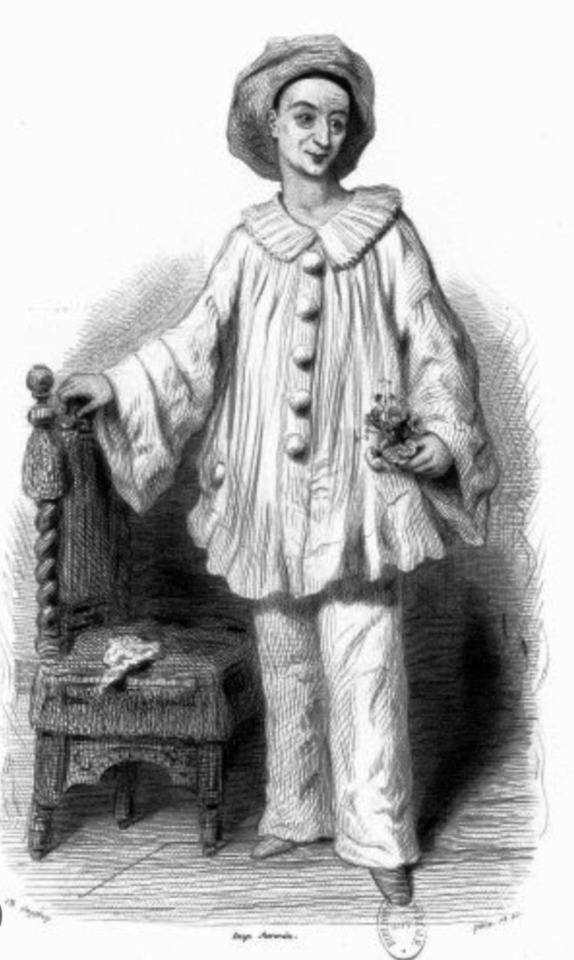
〈pieró〉 (or Pierrot) sm, fr. [der. of the name Pierre «Peter»; owner «Pierino»]. – Character from Italian comedy in France, who originally represented the type of the foolish servant, who then moved on to French pantomime, where he gradually took on the character of a pathetic and unlucky lover.
Il dottore

(Unfortunately I can't post more than 10 photos so take this gif of Mr Bean 🙃, you guys can always look for it)
Balanzone, also known as Doctor Balanzone (Dutåur Balanzån in Bolognese), is a mask of Bolognese origin. He belongs to the ranks of the "old men" of commedia dell'arte, sometimes called Doctor Graziano or simply the Doctor.
Native of Bologna, he is the classic "serious", pedantic and presumptuous character. He is a doctor of law: he is in fact the caricature of the learned and pompous Bolognese lawyer. Its very name proves it, in fact Balanzone derives from the Bolognese balanzån, meaning balance, scales, meaning the symbol of the Law. A man with big red cheeks, he has a big belly and usually gesticulates a lot. He wears a small mask that covers only his eyebrows and nose, resting on two large moustaches. His costume represents the dress of the professors of the University of Bologna: black toga, white collar and cuffs, large Bolognese hat, black jacket and cloak. Fussy, quibbling, he finds every little excuse to start one of his endless meaningless speeches. Always ready to boast of his titles, he says he knows every field of human science: right and law first of all, but also history, astrology, philosophy; he talks about these topics in a boring and long-winded way, mixing them into an inextricable tangle. He enjoys a lot of respect among the other masks who often turn to him for legal advice: he does not deny his help but always takes the opportunity to do the thing he likes most: speaking and giving opinions of no value.
Columbina (Colombina)
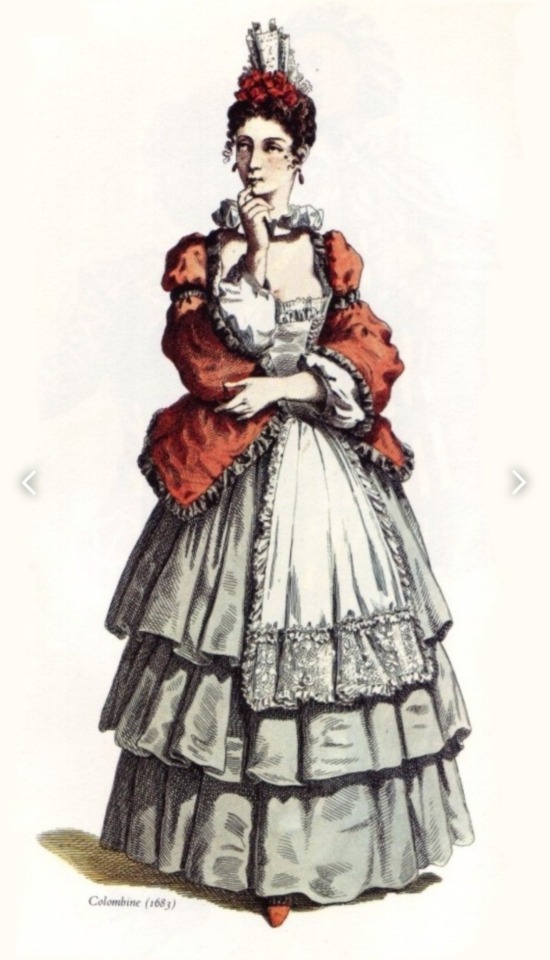
Colombina is a Venetian mask from the commedia dell'arte, often the object of attention from her master Pantalone and the cause of Harlequin's jealousy.
The only female mask to stand out among so many male characters is Colombina, a lively and clever servant girl. She's lively, pretty, a liar and is from Venice. She is very fond of her equally young and pretty lady, Rosaura, and in order to make her happy she is willing to commit scam after scam.
Arlecchino
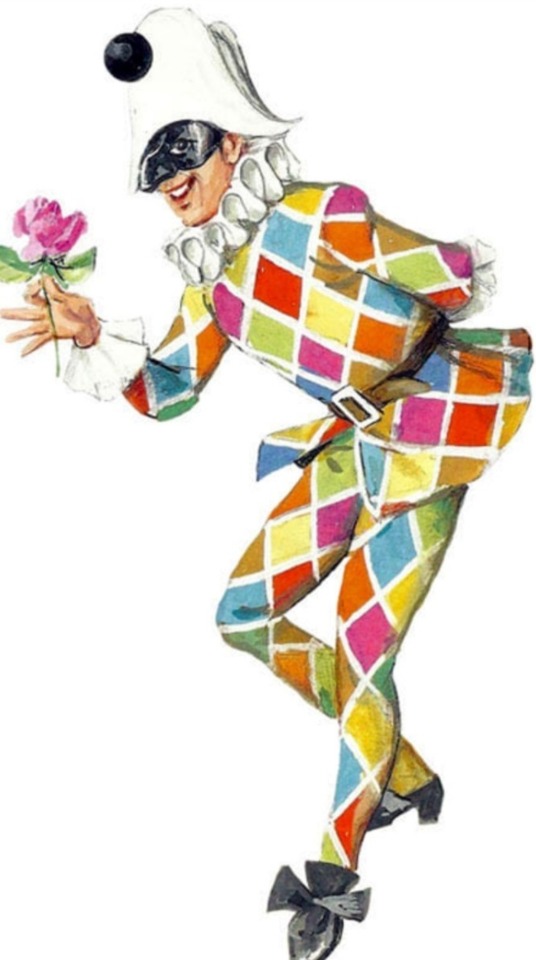
Arlecchino (in Bergamo dialect Arlechì) is a Bergamo mask from the commedia dell'arte.
Identified by his colored lozenge costume, his role is usually that of a carefree and cheerful, but also cunning servant, who acts to thwart the plans of his master Pantalone, in cahoots with his friend Brighella, and to pursue his interest loving, Colombina, with wit and resourcefulness. These characteristics make him assimilate to the typical role of the trickster.
(I'm pretty sure that i made a doll of him when i was in elementary school)
Pulcinella
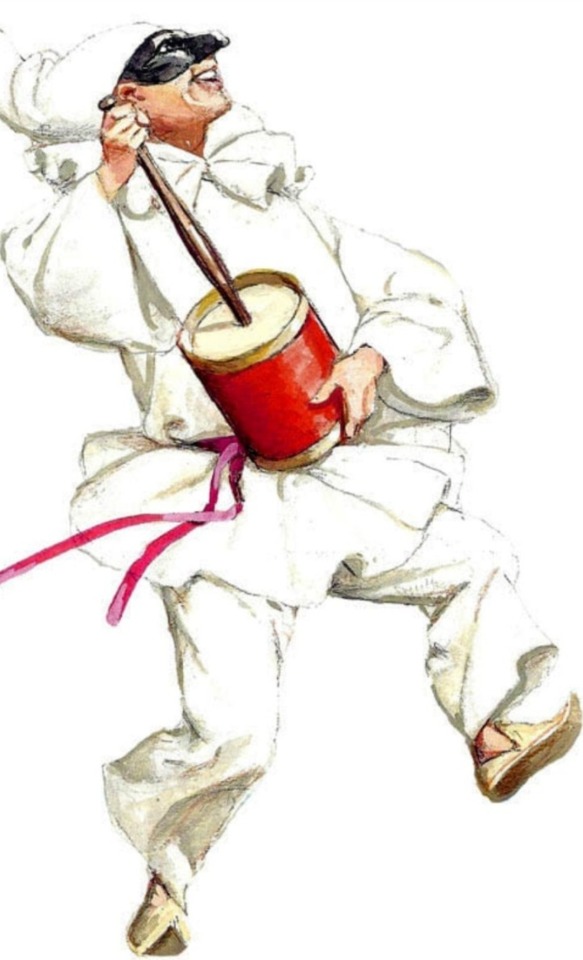
Pulcinella (derived from Puccio d'Aniello, in Neapolitan: Pulecenella) is a Neapolitan mask of the commedia dell'arte.
Pulcinella embodies the Neapolitan plebs, the simplest man, the one who occupies the last place on the social ladder, the man who, despite being aware of his problems, always manages to come out of them with a smile. He is called to represent the soul of the people and their primitive instincts, he almost always appears in contradiction, so much so that he does not have fixed traits: he is rich or poor, he adapts to do all jobs in addition to being a faithful servant, here he is a baker, innkeeper, farmer, thief and seller of miraculous concoctions, he is either arrogant or cowardly, and sometimes presents both traits at the same time by making fun of the powerful. The quality that best distinguishes Pulcinella is his cunning, and it is precisely with his proverbial cunning that he manages to find the ability to solve the most disparate problems that arise before him, but always in favor of the weakest to the detriment of the powerful. Another famous characteristic of his is that of never being able to keep quiet and this is where the expression “pulcinella's secret” comes from, i.e. something that everyone knows. Pulcinella represents a character who has acquired within himself all the symbols and meanings of the popular and peasant world and has brought to all the scenes of Italian theaters, and beyond, a repertoire rich in movements, gestures, acrobatics, typical dances and rituals of the Neapolitan gestural code. In fact, they accompany him on the theater and carnival scenes: the broom, the horn, the cowbells, elements which for the Neapolitans have a propitiatory value and an antidote against the evil eye and jinx.
Scaramouche

Scaramuccia is a mask from the commedia dell'arte, derived from the Captain: boastful and boastful, he dressed in black according to the uniform of the Spaniards stationed in Naples. In truth, however, the mask was born in Naples with the name Scaramuzza, taking on the form Scaramuccia (Tuscan) in the eighteenth century.
(Oh and there is also a film that its called Scaramouche but it doesn't has nothing to do with the mask i think-)
Sandrone
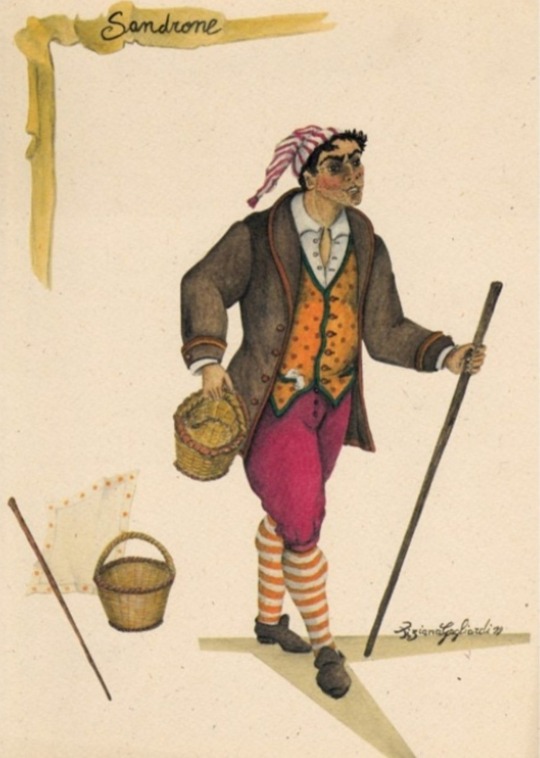
Sandrone (Sandróun in Modenese) is the traditional mask of the city of Modena.
Sandrone represents the peasant of the past, rough, but smart and shrewd. He is the spokesperson of the most humble and mistreated people, and always looking for stratagems to make ends meet.
La signora
No mask found, but translated into English means The lady
Pantalone
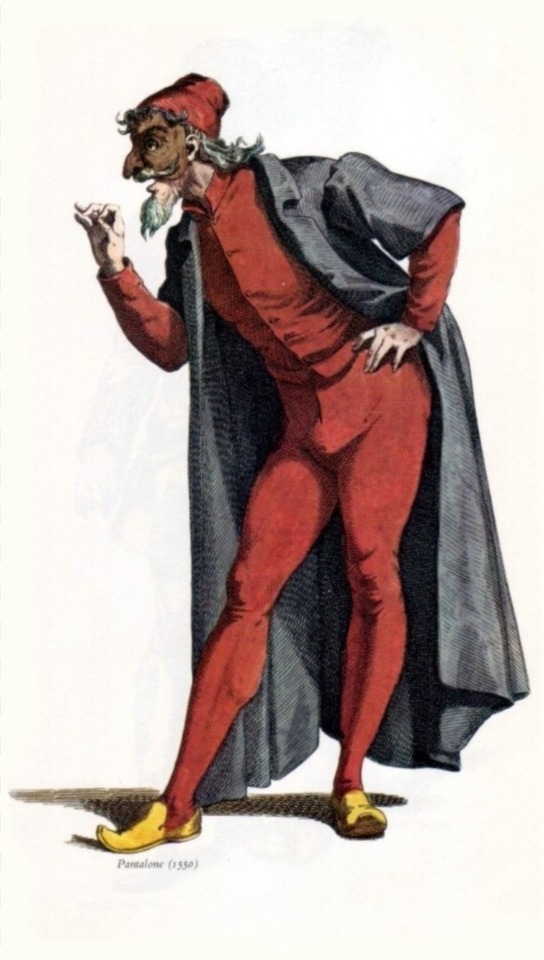
Pantalone (in Venetian Pantalón) is a Venetian mask and a character from the commedia dell'arte.
Pantalone initially appears as a vicious old man who undermines the young lovers, the courtesans, more often the servants of the comedy.
represents the typical old, stingy and lustful merchant: his very name is the one typically imposed on the males of the wealthy families of the Serenissima.
Tartaglia
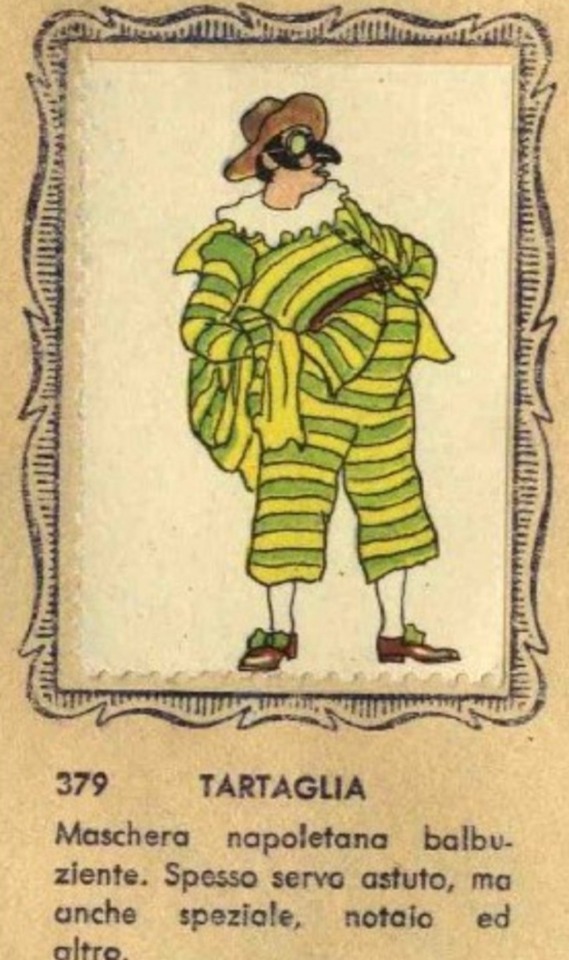
Tartaglia is a mask of the commedia dell'arte, born in Genoa at the beginning of the 1600s. It is similar to that of the doctor, from which it derives.
His main characteristic (hence the name) is stuttering.
Il capitano
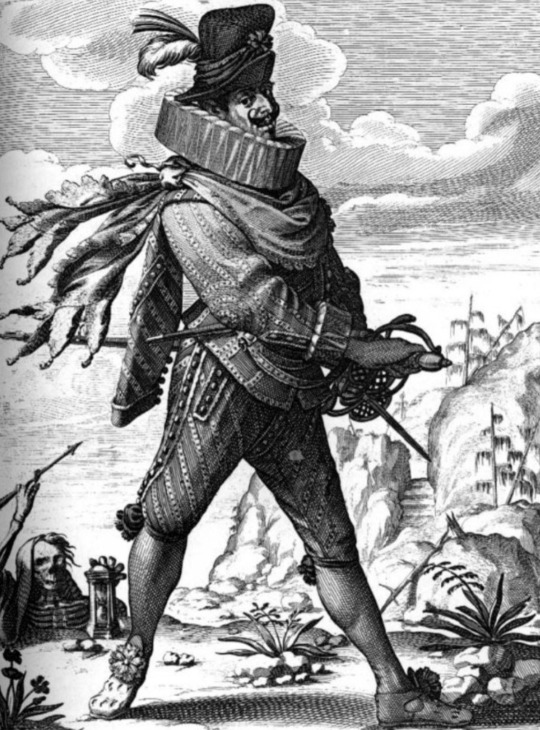
The captain is one of the oldest masks of commedia dell'arte.
Reborn in other forms in the Italian theater of the 1500s, he sometimes personified the noble and imaginative soldier or the vainglorious braggart who boasted of titles he did not possess and of deeds never accomplished: in both cases he actually poorly concealed the terror of having to face a battle or a duel, contrary to what he continually stated in words.
Like they are almost all (-La signora) Italian masks for comedies?! I can't take them seriously anymore 🤣🤣🤣
I don't think that they the personalities match those of the masks but idk anything about them soo~ i could be wrong ^^
If you guys are interested in the Lore of the masks you can just look for them or ask me questions about them if i reamber something
Oh and I used the Google translator because I feel lazy right now
#genshin impact#fatui harbingers#I just ruined everything for everyone-#😈#🤣🤣🤣#omg- but really#i feel like they did it on purpose and i am just repeating things making me look stupid#which I already was#🙃#commedia dell'arte
24 notes
·
View notes
Text
CHARLEY: The Tardis seems to have repaired itself.
DOCTOR: Yeah, everything's back to the way it was before.
CHARLEY: Before what?
DOCTOR: Time and place, Charley. Come on. Where to next? How about a spot of Commedia dell'Arte to cheer you up? Harlequin, Columbina. Of course, my favourite's always been II Dottore.
CHARLEY: How can you be like this?
DOCTOR: What?
CHARLEY: Doctor, C'Rizz is dead. He just turned to dust in front of us, and look at you, all smiles and where to next, Charley.
DOCTOR: I'm sorry.
CHARLEY: Sorry? Just now you said, back to the way it was before. You meant before C'Rizz, didn't you? It's almost as if you're glad. Glad he's gone. Is that it?
DOCTOR: Charley, | don't know what to say to you. | know what's happened is painful for you. CHARLEY: Painful for me? What about you?
DOCTOR: I-
CHARLEY: You never really cared for him, did you, Doctor. Well? Oh, come on, admit it. DOCTOR: Charley, that's just not true.
CHARLEY: Isn't it? Look at yourself. You're perfectly happy to just, | don't know, to carry on as if nothing has happened. How can you do that? Oh, it's because you liked it the way it used to be, before the Divergent Universe. Just you and naive little Charlotte Pollard hanging on your every word.
DOCTOR: Charley, Charley, stop it.
CHARLEY: The little girl you saved from the Web of Time.
DOCTOR: Stop, stop this now.
CHARLEY: The only thing you really care about is this wretched machine. (laughs) Look at you. Now you're hurt.
DOCTOR: People come and go. It's not. Look, it's not that | don't care about them, but CHARLEY: Oh, but what, Doctor?
DOCTOR: Charley, everybody leaves. Everybody. When it comes down to it, there's just me and the Tardis.
CHARLEY: Take me home.
DOCTOR: What?
CHARLEY: | think I've had enough. Yeah, I'm finished.
DOCTOR: Charley, home means somewhere over France, back aboard the R101.
CHARLEY: Does it? | thought this was home.
DOCTOR: Look, | think you just, you need
CHARLEY: I'm going to my room now to pack. | would appreciate it if you could let me know when we've arrived.
DOCTOR: Charley?
CHARLEY: No, Doctor. Remember, everybody leaves.
#cut this on my phone so we are just going to deal with the whole credits sound at the end and the start being dodgy#anyway MAN. everybody leaves huh#messiest breakup since Zagreus#doctor who#sounds#eight#big finish#absolution
15 notes
·
View notes